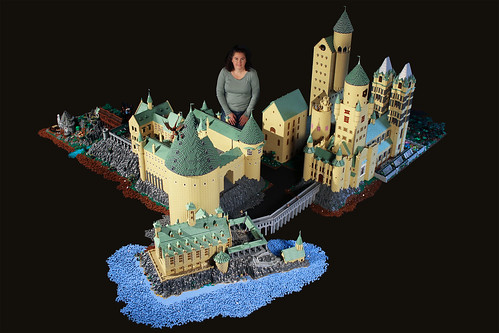Please note that I'm posting this same review across all my blogs, but I'm appending some blog-specific information at the end of each one.

Next up in my series of LEGO book reviews is Extreme Bricks. Last year, when I reviewed A Million Little Bricks: The Unofficial Illustrated History of the LEGO Phenomenon by Sarah Herman, one of my main critiques was that she spent the bulk of the book on a recap of the corporate history of the LEGO Group, and only a handful of pages at the end on the AFOL community. Well, she's come back to the subject to correct this problem. Or perhaps all along she planned on writing two books, one on the company and one on the builders. This book is about MOCs, big ones. The subtitle is "Spectacular, Record-Breaking, and Astounding LEGO Projects from Around the World." That gives you an idea of her focus. This book is all about really big creations.

The book still starts in the corporate world, but I found it more interesting than her previous book. Here she focuses in the first couple of chapters on the large models that LEGO built for in-store promotions and at the first Legoland park, including an extended treatment of the large Sitting Bull by Bjorn Richter. She also looks at things like the James May LEGO house, the giant X-Wing that was unveiled in Times Square, and sculptures comissioned by LEGO. But she quickly moves into things that are probably more interesting to community members, MOCs built by the true fans.

If you read the LEGO blogs, these are mostly things you've seen, like Alice Finch's Hogwarts, the OneLUG March of the Ents, Ed Diment's aircraft carrier, and the like. Names like Sawaya, Kenney, McIntyre, McNaught and other professional builders are all over this book. I really like that Herman interviewed all of the builders, giving backgrounds to the models, building tips, and links to find more of their work online. I have to admit I was a little off-put by the bigness of it all. This is absolutely no knock on the specific MOCs or builders featured, I realize that there are particular challenges and skills involved in building big, but at times it feels like what matters to this book is not that the models are excellent, but that they are really large. It's been pointed out before that when visitors to the public exhibition at fan conventions get to vote on their favorite model, they inevitably choose the largest.

Herman does pretty well at highlighting the community. Many books by people from outside the community, and even from some on the inside, mention Lugnet and the Brothers-Brick and stop there, but Herman does an admirable job of mentioning a variety of online communities, photo-sharing sites, and cons. It's still not the definitive history of the AFOL community that I'd love to see someday, showing the rise and fall of different forums, fests, fan themes, etc, but it's a start.

I do have a couple of critiques. The text reads like it comes from the outside. This does not feel the same as those books written by members of the AFOL community, nor does it feel like the writing of Jonathan Bender, a reporter who started out examining this crazy phenomenon and came to truly love it. It feels like the work of an outsider looking in - a reporter who is certainly impressed by these creations and their builders, but not someone who really knows it in her heart. My other critique is the pictures. This book is smaller than many of the LEGO books I've read - the pages are about 9 inches tall - and the bulk of the images are about a quarter of a page. A book devoted to really large creations should have large pictures, so you can appreciate the actual details of the MOCs rather than just their bigness. This book would have been better served by being at the same size as Brick Shakespeare, another output from the same publishing house, with at least one picture of each MOC that filled the whole page.

Blog-specific content - There's nothing here, which was surprising. Wouldn't it be natural for something like Jürgen Bramigk's Kölner Dom to be in this book? I think she mentioned large cathedrals as one of the sorts of big MOCs that AFOLs build, but I can't find the line in skimming back through the book.
No comments:
Post a Comment